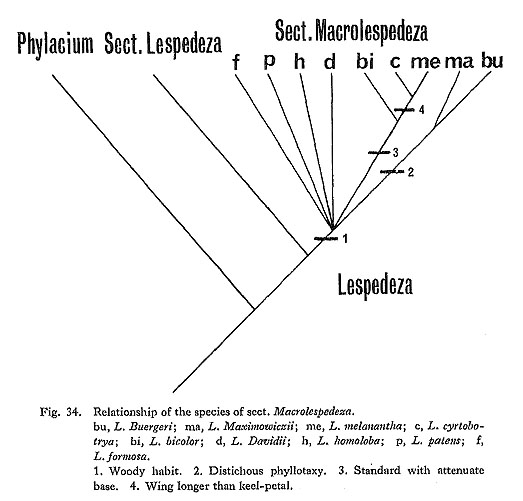Relationships of Species of the Section Macrolespedeza
|
The section Macrolespedeza is a monophyletic group because its woody habit is regarded as an autapomorphic character. The secttion Lespedeza with its herbaceous habit is also a natural group characterized by another autapomorphy, its cleistogamous flower. The genus Phylacium is considered to be an outgroup of the genus Lespedesa. In sect. Macrolespedeza, L. Bitergeri and L. Maximoioiczii have distichous phyllotaxy. The distichous character is considered to be derivative, because the phyllotaxy of the seedlings of L. Buergeri is spiral like that of the other species but later changes to distichous, and the spiral phyllotaxy is more common than the distichous one in Lespedeza, This character is considered to be derivative (apomorphic) and is found only in L. Buergeri and L. Maximowiczii. Thus these two species are taxonomically considered to form a subgroup, the series Heterolespedeza. L. bicolor, L. cyrtobotrya, and L. melanantha have standards with an attenuated base. This shape of standards is also considered to be derivative, because the standard with the clawed base is more common in Lespedeza. The standard with an attenuate base is more derivative than that with a clawed base and observed only in these three species. These three species are therefore put in a subgroup, series Macrolespedeza. In this series L. cyrtobotrya and L. melanantha have wings longer than keel-petals. This character state is also consid ered to be derivative, because L. bicolor and other species of sect. Macrolespedessa have wings shorter than keel-petals. The character state in L. cyrtobotrya and L. me lanantha is regarded as autapomorphy, and thus L. cyrtobotrya is more closely related to L. melanantha than to L. bicolor. L. patens is very similar to L. formosa but no syn-apomorphic character has been found in the floral and vegetative characters. L. patens is different from the latter in its herbaceous nature. This may be due to adaptation to heavy snowfall in the winter season in its habitat. L. homoloba is characterized by well-developed auricles, but except for this character it is similar to L. formosa. The well-developed auricle of the standard may be a specialization. L. Davidii is quite different from other species in vegetative characters such as the shape and texture of leaves and the branches, but no nearest species can be detected in sect. Macrolespe-deza. In L. formosa, L. patens, L. homoloba, and L. Davidii, no autapomorphic character has been found. At present in sect. Macrolespedeza, ser. Heterolespedeza and ser. Macrolespedeza are revealed to be natural groups, but the relationship of the other four species has not been determined. We are tentatively proposing a new series, ser. Formosae, con sisting of these four species.
|
